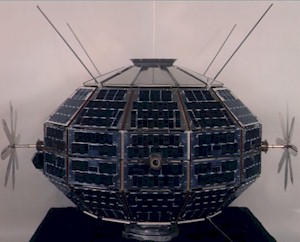Milestones:Alouette-ISIS Satellite Program, 1962: Difference between revisions
m (Text replace - "[[Category:Aerospace engineering |" to "[[Category:Aerospace engineering|") |
No edit summary |
||
| Line 3: | Line 3: | ||
<p>''[[Image:Alouette-ISIS Satellite.jpg|thumb]]Driven by the need to understand the characteristics of radio communication in Canada's North, Canadian researchers focused on the exploration of the earth's upper atmosphere, the ionosphere. Canada's satellite program commenced with the launch of Alouette-I on September 29, 1962. Alouette-II followed in 1965, ISIS-I in 1969, ISIS-II in 1971. The Alouette/ISIS tracking antenna serves as a reminder of Canada's contribution to this international effort in space science. '' </p> | <p>''[[Image:Alouette-ISIS Satellite.jpg|thumb]]Driven by the need to understand the characteristics of radio communication in Canada's North, Canadian researchers focused on the exploration of the earth's upper atmosphere, the ionosphere. Canada's satellite program commenced with the launch of Alouette-I on September 29, 1962. Alouette-II followed in 1965, ISIS-I in 1969, ISIS-II in 1971. The Alouette/ISIS tracking antenna serves as a reminder of Canada's contribution to this international effort in space science. '' </p> | ||
'''The plaque can be viewed at the Shirley's Bay Research Centre, Nepean, | '''The plaque can be viewed at the Shirley's Bay Research Centre, Nepean, Ottawa, in Ontario, Canada.''' | ||
<p>Alouette I, the first Canadian-built satellite, was launched into orbit on 29 September 1962, marking Canada's first foray into space. The satellite was used to study the ionosphere from the top down to learn its effect on radio transmissions. Subsequently, Alouette II was launched in 1965, ISIS (International Satellite for Ionosphere Studies) in 1969 and ISIS II in 1971. By 1990, more than 1,000 papers and reports had been published from information received from the Alouette/ISIS Program. The Alouette/ISIS antenna, which received information from the satellites, is located at Shirley's Bay Research Centre and is preserved as a reminder of Canada's contribution to the international space science effort. </p> | <p>Alouette I, the first Canadian-built satellite, was launched into orbit on 29 September 1962, marking Canada's first foray into space. The satellite was used to study the ionosphere from the top down to learn its effect on radio transmissions. Subsequently, Alouette II was launched in 1965, ISIS (International Satellite for Ionosphere Studies) in 1969 and ISIS II in 1971. By 1990, more than 1,000 papers and reports had been published from information received from the Alouette/ISIS Program. The Alouette/ISIS antenna, which received information from the satellites, is located at Shirley's Bay Research Centre and is preserved as a reminder of Canada's contribution to the international space science effort. </p> | ||
Revision as of 14:55, 22 October 2014
Alouette-ISIS Satellite Program, 1962
Driven by the need to understand the characteristics of radio communication in Canada's North, Canadian researchers focused on the exploration of the earth's upper atmosphere, the ionosphere. Canada's satellite program commenced with the launch of Alouette-I on September 29, 1962. Alouette-II followed in 1965, ISIS-I in 1969, ISIS-II in 1971. The Alouette/ISIS tracking antenna serves as a reminder of Canada's contribution to this international effort in space science.
The plaque can be viewed at the Shirley's Bay Research Centre, Nepean, Ottawa, in Ontario, Canada.
Alouette I, the first Canadian-built satellite, was launched into orbit on 29 September 1962, marking Canada's first foray into space. The satellite was used to study the ionosphere from the top down to learn its effect on radio transmissions. Subsequently, Alouette II was launched in 1965, ISIS (International Satellite for Ionosphere Studies) in 1969 and ISIS II in 1971. By 1990, more than 1,000 papers and reports had been published from information received from the Alouette/ISIS Program. The Alouette/ISIS antenna, which received information from the satellites, is located at Shirley's Bay Research Centre and is preserved as a reminder of Canada's contribution to the international space science effort.
Alouette/ISIS was initiated in 1958 by Dr. John H. Chapman, IEEE Fellow '64 (1921-1979), director of the Defence Research Telecommunications Agency. Over time, three government agencies -- Communications Research Centre, Defence Research Establishment Ottawa, and Canadian Space Agency -- took over the program, which concluded in 1984.
<googlemap controls="small" height="250" width="300" zoom="10" lon="-75.853531" lat="45.351207" version="0.9"> 45.351207, -75.853531, Code-breaking at Bletchley Park during World War II, 1939-1945 Bletchley Park, Milton Keynes, England </googlemap>
